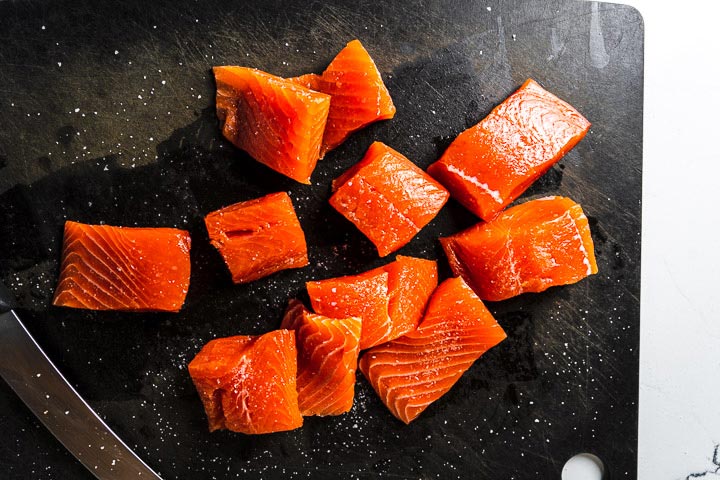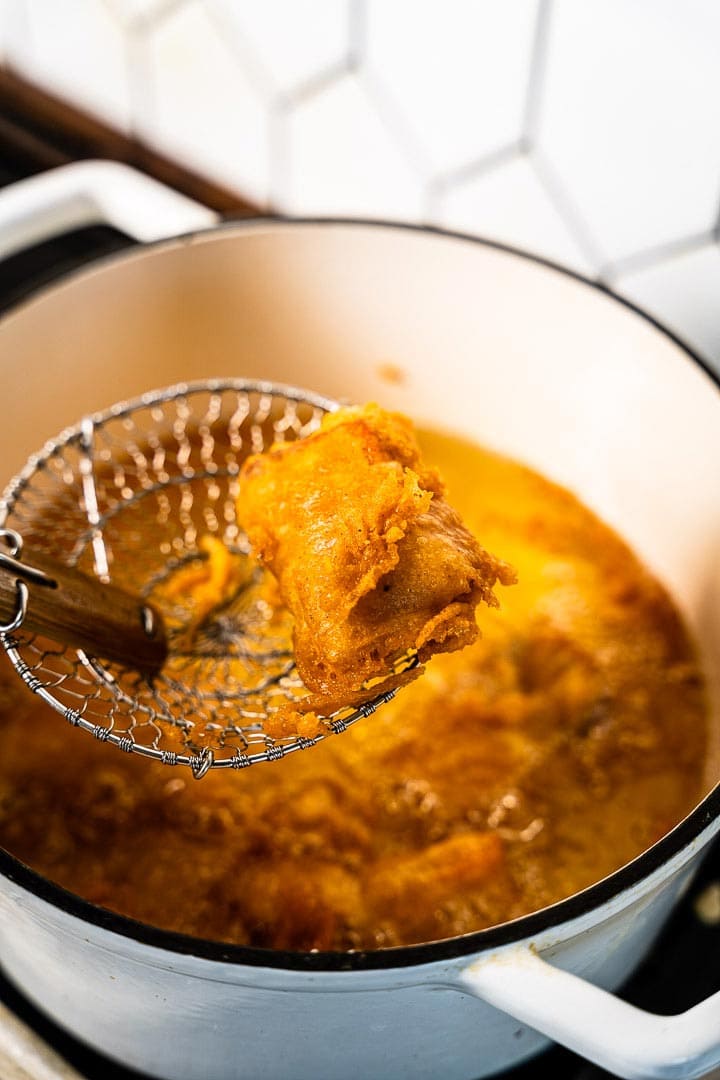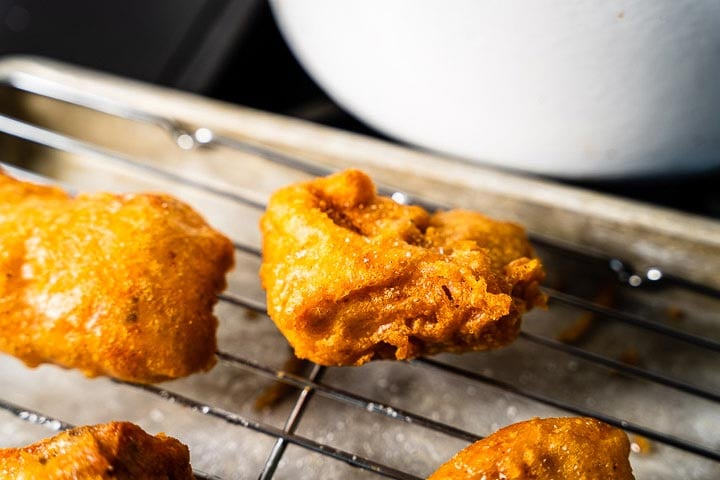I’m someone who loves salmon all the ways, but this one just might be the new favorite. The first loud crunch through that light and airy flavorful crust, followed by the delicious salmon, is memorable. Not only is it one of the best ways to enjoy this beautiful fish, but you don’t even need a deep fryer. Just some beautiful salmon, a cold beer and a few simple ingredients.
Crispy deep fried salmon encased in a light, golden brown crust is one of the most delicious ways to enjoy this flavorful fish. Taking salmon from the ordinary to extraordinary, deep frying coaxes out its best qualities – moist flaky meat with a satisfying crunch.
While deep frying does require some special equipment and safety measures, the results are well worth it. This step-by-step guide will teach you how to deep fry salmon like a pro, from how to cut the fish properly to frying at just the right temperature for maximum crispiness.
Here is a great seafood recipe that you can make at home after reading it. Let’s get started!.
Why Deep Fry Salmon?
There are several advantages to deep frying salmon versus other cooking methods
-
The oil’s high heat cooks the salmon quickly and keeps the juices and moisture inside.
-
Frying gives salmon a wonderfully crisp, golden exterior without drying it out.
-
Flavors from a light batter or breading are amplified.
-
Deep frying showcases salmon’s richness and pairs well with sauces.
-
It’s a quick and easy cooking method with impressive results.
For salmon lovers, deep fried salmon is a must-try recipe that will upgrade this healthy fish to a gourmet level.
Tips for Choosing Salmon for Deep Frying
When selecting salmon fillets for deep frying, opt for:
-
Sustainably-caught wild salmon like sockeye or coho.
-
Even thickness so pieces cook at the same rate.
-
Skin and pinbones removed for easier eating.
-
Firm, shiny salmon without any dull or dry areas.
-
Fillets about 1-1.5 inches thick to allow even frying.
Thicker cut salmon holds up better to frying than thin tail sections. Frozen salmon works well too.
How to Cut Salmon for Deep Frying
Properly cutting the salmon helps ensure it fries evenly into tender, flaky pieces:
-
Trim fillets into rectangular portions approximately 3-4 inches long.
-
Cut each piece across the width of the fillet into 2-3 strips, based on thickness.
-
Slices should be 1-1.5 inches wide and about 3/4 inch thick.
-
Uniform sizing allows the salmon to cook at the same pace.
Cut the salmon just before frying for best texture and moisture retention.
Breading Salmon for Deep Frying
Breading adds crunch and great flavor. Try these easy breading methods:
-
Flour-egg-breadcrumb: Dust salmon in flour, dip in beaten egg, then coat with panko or breadcrumbs.
-
Beer batter: Dip fillets in a light batter of flour, beer, and spices.
-
Cornmeal: For Southern style, coat salmon in seasoned cornmeal.
-
Spiced flour: For convenience, just dredge salmon in flour mixed with spices.
Apply coatings right before frying so they stay crisp. Let excess drip off before frying.
How to Deep Fry Salmon Step-By-Step
Once your salmon is prepped, it’s time to fry. Follow these steps:
-
Pour oil at least 3-4 inches deep in a heavy pot or Dutch oven and heat to 350°F.
-
Pat salmon dry and coat with selected breading. Let adhere for 5 minutes.
-
Fry in batches of 2-3 pieces to maintain oil temperature.
-
Cook about 4-5 minutes per side until golden brown, flipping once.
-
Drain on a rack, season with salt and serve warm.
Use a thermometer and adjust heat to keep oil between 325-375°F. Overheating risks burning the crust before salmon is cooked through.
Deep Frying Safety Tips
Like any high-heat cooking method, deep frying comes with some safety considerations:
-
Always monitor the hot oil closely and don’t leave it unattended.
-
Let kids participate only with close supervision.
-
Keep the handles of pots and lids facing away from the front of the stove.
-
Don’t overfill pots with oil which can bubble over dangerously.
-
Allow the oil to fully cool before disposing or straining for reuse. Hot oil can easily ignite if mishandled.
With some care and attention, deep frying at home can be done safely with delicious results!
The Best Oils for Deep Frying Salmon
Choosing the right frying oil makes a difference in the end result:
-
Peanut oil – A favorite for deep frying with a high smoke point and neutral flavor.
-
Canola oil – Another neutral-flavored oil good for deep frying.
-
Vegetable oil – A budget-friendly option you likely have on hand. Good all-purpose oil.
-
Grapeseed oil – A light oil that lets the salmon flavor shine through.
-
Corn oil – Works well for deep frying and offers a hint of corn flavor.
Whichever you use, always heat the oil slowly and test the temperature before adding food.
Serving Suggestions for Deep Fried Salmon
Deep fried salmon deserves accompaniments as delicious as itself. Some ideas:
-
Homemade tartar sauce or creamy garlic aioli for dipping
-
A squeeze of fresh lemon
-
Coleslaw or potato salad
-
French fries
-
Rice pilaf or cous cous
-
Sauteed vegetables like zucchini or squash
-
A crisp green salad with vinaigrette
-
Wedges of lemon or lime
FAQs About Deep Frying Salmon
Here are answers to some common deep frying questions:
What temperature should I fry salmon? Heat oil between 325°F and 375°F. Salmon cooks best at 350°F.
How long does it take to fry salmon? 4 to 5 minutes per side for 1-inch thick pieces. Larger cuts may need a minute or two longer.
Can I fry salmon without breading? Yes, plain salmon can be fried but the coating helps seal in moisture and provides crunch.
Does the skin need to be removed before frying? Yes, remove skin which can toughen when fried. The skin can also make the salmon curl.
What size pot do I need? Use at least a 5-6 quart pot so the oil doesn’t bubble over. Wider is better than taller.
Can I reuse frying oil? Oil can be reused a few times for frying fish but has a shorter shelf life than oil used for lower temperatures.
Tasty Recipes for Your Deep Fried Salmon
Once you’ve mastered the art of deep frying salmon, try out these fun recipes:
-
Salmon fish tacos – Crispy fried salmon wrapped in warm tortillas with zesty slaw and salsa.
-
Salmon po’ boys – Pile fried salmon onto a soft sub roll with lettuce, tomato and remoulade sauce.
-
Salmon croquettes – Make crispy salmon patties flecked with herbs, spices and vegetables.
-
Salmon cakes – Pan-fry breaded salmon cakes for a lighter crisp texture.
-
Southern salmon patties – Bind together flavorful fried salmon flakes with eggs and breadcrumbs.
However you decide to enjoy your deep fried salmon, this simple recipe is sure to impress. With its contrast of hot, crispy exterior and moist, flaky fish, deep fried salmon takes this healthy protein to new heights. Frying up salmon has never been so fast and delicious!

The Sauce Brings It All Together: Homemade Tartar Sauce
- 1/2 cup mayonnaise
- 2 teaspoons sweet relish
- 1 to 2 teaspoons of lemon juice (depending on how you like it; each lemon is different)
- 1 teaspoon Dijon mustard
- Black or white pepper
- 1/4 teaspoon Worcestershire sauce
- 1/3 teaspoon cayenne for heat (optional)
Whisk all the ingredients in a small bowl until well combined. Taste for seasoning and balance. Adjust accordingly. Serve chilled.
How to Make Deep-Fried Salmon
Let’s go step-by-step with how to make this amazing and easy crispy deep-fried salmon.
- Get the salmon ready by taking off the skin and pin bones. For even cooking, cut into equal-sized pieces and sprinkle kosher salt and pepper on all sides.
Tip: Cut the fish into even-size pieces so they are all finished cooking at the same time.

- Heat the oil. Get a Dutch oven with high sides and add enough oil to cover the salmon while it fries. About 3 to 4 inches should do. Heat it to 375° F.
- To make the batter, mix the dry ingredients together. Then, add the egg and beer and whisk slowly until the batter is smooth.
Tip: Don’t forget to salt the fish before putting it in the batter to make it taste better. You can do this while you’re getting ready, or even an hour ahead of time. And also season it again right when it’s out of the oil with a little more coarse salt.
- The salmon should be dipped in the batter with a fork and then put in the hot oil. Move it around a few times before letting it drop in. Fry for three to four minutes on each side, using a spider to turn them over halfway through.
Tip: Fry in batches so the pot doesn’t get too full, which will cause the oil to cool. Hot oil makes the batter super crispy without getting soggy and absorbing too much oil.

- Season and serve: Put the fried salmon on a wire rack set on top of a sheet pan to cool down, and sprinkle it with kosher salt right away. Then serve it right away with a quick recipe for homemade tartar sauce while it’s still hot and crunchy.
Tip: After it’s out of the oil, drip dry on a wire cooling rack, not on paper towels. This keeps it crispy so it doesn’t get soggy sitting in oil.

